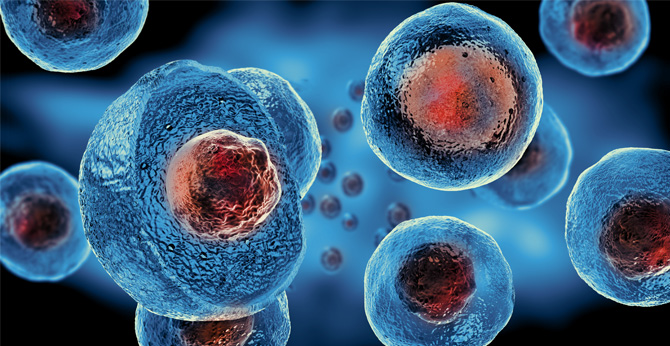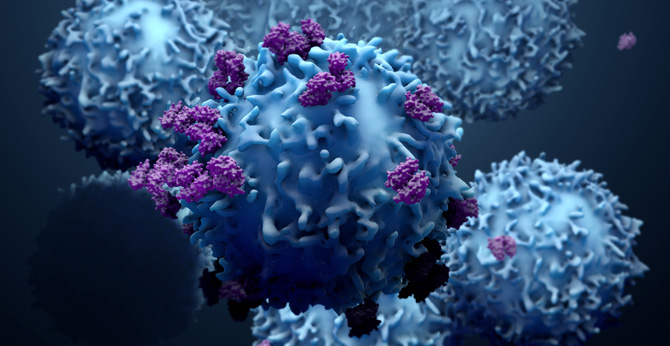All products and services are For Research Use Only and CANNOT be used in the treatment or diagnosis of disease.
Our team of experts has extensive experience in CAR-T cell development and comprehensive anti-GPC1 CAR-T products and services for our clients.
Glypican-1 (GYC1) is a member of the GRIPS family of proteoglycans. Cell surface heparan sulfate proteoglycans are composed of a membrane-associated protein core substituted with a variable number of heparan sulfate chains. Members of the glypican-related integral membrane proteoglycan family (GRIPS) contain a core protein anchored to the cytoplasmic membrane via a glycosyl phosphatidylinositol linkage. These proteins may play a role in the control of cell division and growth regulation. GYC1 has been shown to interact with several growth factors, including fibroblast growth factor (FGF), hedgehog, and Wnt proteins, and to regulate their signaling activities.
Liver cancer
Melanoma
Pancreatic cancer
Anti-GYC1 CAR-T Expression Test
At Creative Biolabs, we offer several methods to detect CAR expression, including flow cytometry, qPCR, and WB. Protein L and anti-Fab antibodies are common tools for the detection and quantification of anti-GPC1 CAR.
 Fig.1 Flow cytometry analysis of CAR expression by detection of hEGFRt expression.1
Fig.1 Flow cytometry analysis of CAR expression by detection of hEGFRt expression.1
Anti-GYC1 CAR-T Cytokine Release Test
Our comprehensive cytokine release test services detect a wide range of cytokines, including IL-2, TNF-α, and IFN-γ.
 Fig.2 The expression of cytokines in GYC1 CAR-T cells co-cultured with T3M4 cells.1 The various constructs showed different levels of cytokine release (IFN-γ and IL-2) in the co-cultured supernatants.
Fig.2 The expression of cytokines in GYC1 CAR-T cells co-cultured with T3M4 cells.1 The various constructs showed different levels of cytokine release (IFN-γ and IL-2) in the co-cultured supernatants.
Anti-GYC1 CAR-T In Vitro Cytotoxicity Assay
We use some common methods for evaluating the cytotoxicity of anti-GYC1 CAR-T cells, including a bioluminescence-based assay, LDH release assay, and flow cytometry assay.
 Fig.3 The cytotoxic potential of anti-GYC1L CAR-T against GYC1+cell lines (high GPC1-expressing 2B9 cells and low GPC1-expressing T3M4 cells).1 GYC1L CAR-T cells exhibited antigen-specific cytotoxicity against GYC1+ cells and showed different cytotoxic potential to T3M4 cells.
Fig.3 The cytotoxic potential of anti-GYC1L CAR-T against GYC1+cell lines (high GPC1-expressing 2B9 cells and low GPC1-expressing T3M4 cells).1 GYC1L CAR-T cells exhibited antigen-specific cytotoxicity against GYC1+ cells and showed different cytotoxic potential to T3M4 cells.
Anti-GYC1 CAR-T Cell Therapy Animal Models
At our lab, we offer a range of in vivo anti-GYC1L CAR-T cell therapy testing mouse models, including xenograft, humanized, syngeneic, and transgenic models. These animal models play a crucial role in the development and evaluation of CAR-T therapies.
 Fig.4 Experimental schematic of CAR-T therapy xenograft mouse model.1
Fig.4 Experimental schematic of CAR-T therapy xenograft mouse model.1
Efficacy Test of Anti-GYC1 CAR-T
Creative Biolabs provides services to evaluate the therapeutic efficacy of anti-GPC1 CAR T cells in vivo. In vivo antitumor activity of anti-GPC1 CAR T cells against GPC1+ cancer cells is assessed by the detection of the tumor growth and survival of mice.
 Fig.5 In vivo evaluation of the antitumor activity of GYC1 CAR-T in a xenograft mouse model.1 The results showed that IgG4H-CD28TM CAR T cells rapidly eliminated T3M4 tumor cells in mice.
Fig.5 In vivo evaluation of the antitumor activity of GYC1 CAR-T in a xenograft mouse model.1 The results showed that IgG4H-CD28TM CAR T cells rapidly eliminated T3M4 tumor cells in mice.
Toxicity Evaluation Anti-GPC1 CAR-T
Our scientists have rich experience in the evaluation of the toxicity of CAR-T cells. We provide various CAR-T toxicity study services including tumorigenicity study, on-target toxicity, and off-target toxicity.
Reference
 Loading...
Loading...
| CAT | Product Name | Target Species | Antibody Clone | Antibody Host | Receptor Construction | Vector Type | Targeting Cell Type | CAR Vector Type | Inquiry & Datasheet |
| XS-0822-LX101 | Anti-GPC1 (X8X101) h(CD28-41BB-CD3ζ) CAR, pCDCAR1 | Human | X8X101 | Mouse | scFv-CD28-41BB-CD3ζ | Lentiviral vector | T cell | ||
| XS-0822-LX102 | Anti-GPC1 (X8X102) h(CD28-41BB-CD3ζ) CAR, pCDCAR1 | Human | X8X102 | Mouse | scFv-CD28-41BB-CD3ζ | Lentiviral vector | T cell | ||
| XS-0822-LX103 | Anti-GPC1 (X8X103) h(CD28-41BB-CD3ζ) CAR, pCDCAR1 | Human | X8X103 | Mouse | scFv-CD28-41BB-CD3ζ | Lentiviral vector | T cell | ||
| XS-0822-LX104 | Anti-GPC1 (X8X104) h(CD28-41BB-CD3ζ) CAR, pCDCAR1 | Human | X8X104 | Mouse | scFv-CD28-41BB-CD3ζ | Lentiviral vector | T cell | ||
| XS-0822-LX283 | Anti-GPC1 (X8X96) h(CD28-OX40-CD3ζ) CAR, pCDCAR1 | human | X8X96 | Humanized | scFv-CD28-OX40-CD3ζ | Lentiviral vector | T cell | ||
| XS-0822-LX284 | Anti-GPC1 (X8X97) h(CD28-OX40-CD3ζ) CAR, pCDCAR1 | human | X8X97 | Humanized | scFv-CD28-OX40-CD3ζ | Lentiviral vector | T cell | ||
| XS-0822-LX285 | Anti-GPC1 (X8X98) h(CD28-OX40-CD3ζ) CAR, pCDCAR1 | human | X8X98 | Humanized | scFv-CD28-OX40-CD3ζ | Lentiviral vector | T cell | ||
| XS-0822-LX286 | Anti-GPC1 (X8X99) h(CD28-OX40-CD3ζ) CAR, pCDCAR1 | human | X8X99 | Humanized | scFv-CD28-OX40-CD3ζ | Lentiviral vector | T cell | ||
| XS-0822-LX287 | Anti-GPC1 (X8X100) h(CD28-OX40-CD3ζ) CAR, pCDCAR1 | Human | X8X100 | Mouse | scFv-CD28-OX40-CD3ζ | Lentiviral vector | T cell | ||
| XS-0822-LX288 | Anti-GPC1 (X8X101) h(CD28-OX40-CD3ζ) CAR, pCDCAR1 | Human | X8X101 | Mouse | scFv-CD28-OX40-CD3ζ | Lentiviral vector | T cell | ||
| XS-0822-LX289 | Anti-GPC1 (X8X102) h(CD28-OX40-CD3ζ) CAR, pCDCAR1 | Human | X8X102 | Mouse | scFv-CD28-OX40-CD3ζ | Lentiviral vector | T cell | ||
| XS-0822-LX290 | Anti-GPC1 (X8X103) h(CD28-OX40-CD3ζ) CAR, pCDCAR1 | Human | X8X103 | Mouse | scFv-CD28-OX40-CD3ζ | Lentiviral vector | T cell | ||
| XS-0822-LX291 | Anti-GPC1 (X8X104) h(CD28-OX40-CD3ζ) CAR, pCDCAR1 | Human | X8X104 | Mouse | scFv-CD28-OX40-CD3ζ | Lentiviral vector | T cell | ||
| XS-0822-LX292 | Anti-GPC1 (X8X105) h(CD28-OX40-CD3ζ) CAR, pCDCAR1 | Human | X8X105 | Mouse | scFv-CD28-OX40-CD3ζ | Lentiviral vector | T cell | ||
| XS-0822-LX293 | Anti-GPC1 (X8X106) h(CD28-OX40-CD3ζ) CAR, pCDCAR1 | Human | X8X106 | Mouse | scFv-CD28-OX40-CD3ζ | Lentiviral vector | T cell | ||
| XS-0822-LX470 | Anti-GPC1 (X8X96) h(ICOS-41BB-CD3ζ) CAR, pCDCAR1 | human | X8X96 | Humanized | scFv-ICOS-4-1BB-CD3ζ | Lentiviral vector | T cell | ||
| XS-0822-LX471 | Anti-GPC1 (X8X97) h(ICOS-41BB-CD3ζ) CAR, pCDCAR1 | human | X8X97 | Humanized | scFv-ICOS-4-1BB-CD3ζ | Lentiviral vector | T cell | ||
| XS-0822-LX472 | Anti-GPC1 (X8X98) h(ICOS-41BB-CD3ζ) CAR, pCDCAR1 | human | X8X98 | Humanized | scFv-ICOS-4-1BB-CD3ζ | Lentiviral vector | T cell | ||
| XS-0822-LX473 | Anti-GPC1 (X8X99) h(ICOS-41BB-CD3ζ) CAR, pCDCAR1 | human | X8X99 | Humanized | scFv-ICOS-4-1BB-CD3ζ | Lentiviral vector | T cell | ||
| XS-0822-LX474 | Anti-GPC1 (X8X100) h(ICOS-41BB-CD3ζ) CAR, pCDCAR1 | Human | X8X100 | Mouse | scFv-ICOS-4-1BB-CD3ζ | Lentiviral vector | T cell | ||
| XS-0823-LX62 | Anti-hGPC1 (1.4) ICD(CD28-OX40-CD3ζ) CAR-MA, pAd5f35 Vector | Human | 1.4 | Adenoviral vectors |
 NEWSLETTER
NEWSLETTER
The latest newsletter to introduce the latest breaking information, our site updates, field and other scientific news, important events, and insights from industry leaders
LEARN MORE NEWSLETTER NEW SOLUTION
NEW SOLUTION
CellRapeutics™ In Vivo Cell Engineering: One-stop in vivo T/B/NK cell and macrophage engineering services covering vectors construction to function verification.
LEARN MORE SOLUTION NOVEL TECHNOLOGY
NOVEL TECHNOLOGY
Silence™ CAR-T Cell: A novel platform to enhance CAR-T cell immunotherapy by combining RNAi technology to suppress genes that may impede CAR functionality.
LEARN MORE NOVEL TECHNOLOGY NEW SOLUTION
NEW SOLUTION
Canine CAR-T Therapy Development: From early target discovery, CAR design and construction, cell culture, and transfection, to in vitro and in vivo function validation.
LEARN MORE SOLUTION